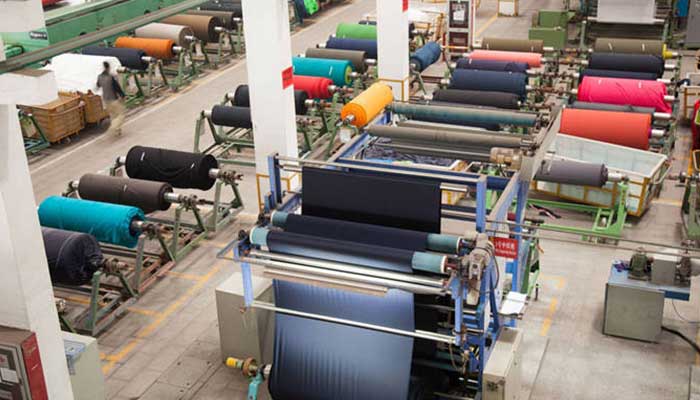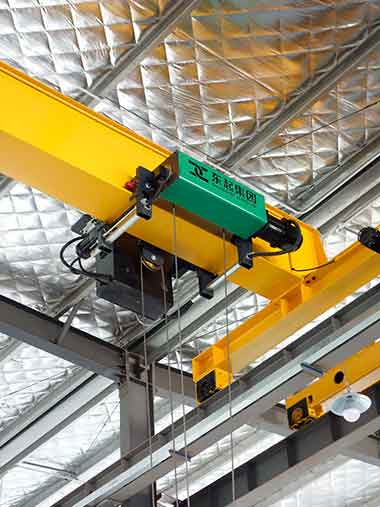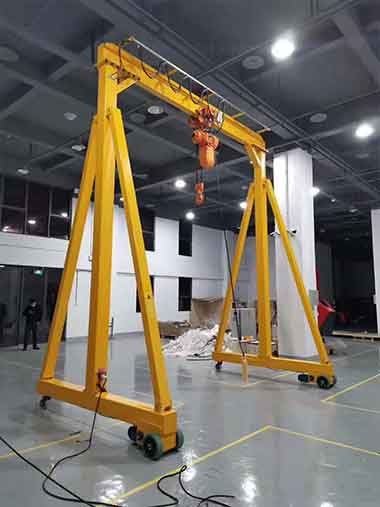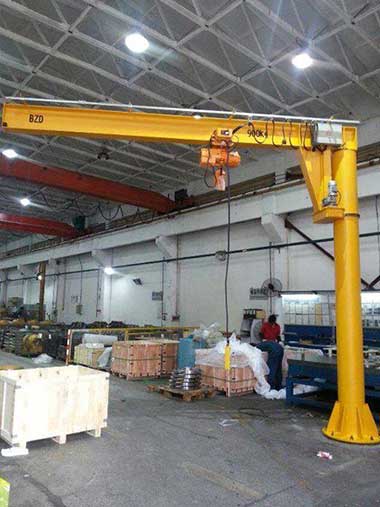Overhead Crane for Textile Factory, Single & Double Girder Crane
Overhead crane for textile industry. All types of overhead crane improve your material handling in textile Production, Dyeing and Finishing & others.

Customized overhead crane for sale textile industry
Types of Overhead Cranes for Textile Industry:
Overhead cranes are crucial material handling equipment used in the textile industry to efficiently move, lift, and transport heavy loads throughout various stages of production. Different types of overhead cranes are employed based on their specific applications and the lifting requirements of the textile facility. Here is an overview of the common types of overhead cranes used in the textile industry:

a. Single Girder Overhead Crane:
- Description: Single girder overhead cranes consist of a single horizontal beam supported by end trucks or runway beams. The hoist and trolley move along the lower flange of the girder.
- Applications: Single girder cranes are widely used in textile facilities for light to medium-duty material handling tasks. They are suitable for moving spools of yarn, intermediate fabric rolls, and other smaller materials between workstations.
b. Double Girder Overhead Crane:
- Description: Double girder overhead cranes have two parallel horizontal beams that support the hoist and trolley. The hoist moves between the two girders.
- Applications: Double girder cranes are used in textile manufacturing plants when handling heavier loads, such as large rolls of fabric, bales of raw materials, or other significant material loads.


c. Gantry Crane:
- Description: Gantry cranes are similar to overhead cranes but are supported by freestanding legs running on rails or wheels. This design allows them to move independently of the building structure.
- Applications: Gantry cranes are often used in textile warehouses, outdoor storage areas, or areas where overhead support is not feasible. They are suitable for handling large fabric rolls, loading/unloading shipments, and organizing materials in storage yards.
d. Jib Crane:
- Description: Jib cranes consist of a vertical mast mounted on a stable base, with a horizontal jib arm that can rotate. The hoist and trolley move along the jib arm.
- Applications: Jib cranes are ideal for localized material handling tasks within the textile industry, such as loading and unloading machines, transferring materials between workstations, and positioning fabrics for inspection.

Each type of overhead crane offers distinct advantages and is selected based on factors like the facility's layout, lifting capacity requirements, available space, and specific material handling tasks in the textile production process. Properly chosen and maintained overhead cranes contribute to improved efficiency, reduced downtime, and enhanced safety in textile manufacturing facilities.
Light and heavy duty overhead cranes for textile Industry
The capacity of overhead cranes used in the textile industry can vary based on the specific material handling requirements of each facility. However, the most popular capacity ranges for overhead cranes in the textile industry typically fall within the following categories:
- 1. Light to Medium Capacity Cranes:
- Capacity Range: 1 ton to 10 tons
- Application: These cranes are commonly used for handling lighter materials, such as spools of yarn, intermediate fabric rolls, and other smaller components in the textile production process. - 2. Medium to Heavy Capacity Cranes:
- Capacity Range: 10 tons to 50 tons
- Application: Cranes in this capacity range are utilized for handling heavier loads, including large fabric rolls, bales of raw materials, or finished textile products. - 3. Heavy Duty Cranes:
- Capacity Range: 50 tons and above
- Application: Heavy-duty cranes are employed for specialized tasks in the textile industry that involve exceptionally heavy materials, machinery, or equipment.
The selection of the crane capacity depends on factors such as the weight and dimensions of the materials being handled, the production process, and the layout of the textile facility. Manufacturers often customize overhead crane solutions to match the specific needs and lifting capacity requirements of each textile facility. It's essential to choose an overhead crane that can handle the maximum load capacity needed for efficient material handling while ensuring safety and compliance with relevant regulations.
Material handling overhead crane for various stages of textile production
Material handling is a critical aspect of textile manufacturing, and overhead cranes play a crucial role in facilitating efficient and safe material movement throughout the various stages of production. Here's how overhead cranes are essential for material handling in the textile industry:
- 1. Raw Material Handling:
- Overhead cranes are used to unload raw materials, such as bales of cotton, wool, or synthetic fibers, from trucks or containers upon arrival at the textile facility.
- They transport the raw materials to designated storage areas or directly to the processing area, ensuring a smooth flow of materials from the point of entry. - 2. Fiber Production:
- Overhead cranes are utilized in fiber production facilities to handle materials during the manufacturing process. They can move raw fibers to different stages of production, such as from fiber preparation to spinning machines. - 3. Yarn Production:
- Overhead cranes play a role in yarn production by transporting spools of yarn between different machines, such as from winding to twisting or from twisting to dyeing.
- They ensure the continuous flow of yarn through the production line, reducing downtime and increasing efficiency. - 4. Weaving and Knitting:
- Overhead cranes handle large rolls of fabrics produced from weaving or knitting machines. They transport the rolls to inspection areas, cutting tables, or packing stations.
- The cranes contribute to the efficient organization of fabrics and help in positioning materials for further processing. - 5. Dyeing and Finishing:
- Overhead cranes assist in moving heavy textile materials, such as fabric rolls or batches, to dyeing or finishing machines.
- They play a crucial role in ensuring that delicate fabrics are handled carefully to avoid damage during transportation. - 6. Fabric Inspection and Quality Control:
- Overhead cranes are used to lift and position fabric rolls for inspection and quality control purposes.
- They enable precise and controlled movement of fabrics, making it easier for inspectors to examine the material thoroughly. - 7. Finished Product Handling:
- Overhead cranes transport finished textile products, such as clothing, home textiles, or industrial textiles, from the production area to packaging or storage.
- They facilitate the loading of finished goods onto trucks for distribution to retailers or end consumers.
Throughout the textile manufacturing process, overhead cranes optimize material handling, streamline production, and reduce the manual labor required for moving heavy and bulky loads. By efficiently moving materials, overhead cranes contribute to increased productivity, reduced processing time, and minimized risks of material damage or workplace injuries. They play a vital role in maintaining a smooth and organized flow of materials from raw fibers to finished products, ensuring the overall efficiency of the textile production process.
 single girder bridge crane for textile fabrication workshop
single girder bridge crane for textile fabrication workshop
Crane Safety in Textile Industry:
Crane safety is of paramount importance in the textile industry to protect personnel, prevent accidents, and maintain a productive work environment. Implementing best practices for safe operation, maintenance, and inspection of overhead cranes is essential to ensure the safety of workers and the proper functioning of the crane system. Here are some best practices for crane safety in textile manufacturing plants:
- 1. Operator Training and Certification:
- Ensure that all crane operators receive proper training and certification in crane operation. Training should cover safe operating procedures, load capacity limits, emergency procedures, and the use of safety devices. - 2. Regular Inspections:
- Conduct regular inspections of the overhead cranes as per the manufacturer's recommendations and relevant safety standards. Inspections should be performed by qualified personnel to identify any potential issues or wear and tear that may affect crane performance. - 3. Preventive Maintenance:
- Establish a preventive maintenance program for overhead cranes. Regularly inspect and maintain all crane components, including hoists, trolleys, and runway beams, to ensure they are in optimal working condition. - 4. Load Capacity Compliance:
- Never exceed the crane's rated load capacity. Crane operators should be aware of the load limits and never attempt to lift loads beyond the crane's capacity to avoid accidents. - 5. Load Centering:
- Properly center the load on the crane's hook to maintain stability during lifting and prevent swinging or shifting of the load. - 6. Use of Safety Devices:
- Ensure that all required safety devices, such as limit switches, overload protection, emergency stop buttons, and warning alarms, are functional and in place on the crane. - 7. Clear Communication:
- Establish clear communication protocols between crane operators and ground personnel to ensure safe movements and material handling. - 8. Restricted Access:
- Restrict access to the crane's operating area to authorized personnel only. Unauthorized individuals should not be allowed near the crane during its operation. - 9. PPE (Personal Protective Equipment):
- Mandate the use of appropriate personal protective equipment, such as helmets, gloves, and safety harnesses, for crane operators and ground personnel in the crane area. - 10. Safe Lifting Practices:
- Train operators in safe lifting practices, including proper load attachment and detachment techniques, to prevent accidents during material handling. - 11. Emergency Procedures:
- Ensure that all personnel involved in crane operations are familiar with emergency procedures, including procedures for handling power outages or equipment malfunctions. - 12. Compliance with Safety Standards:
- Adhere to relevant safety standards and regulations specific to overhead cranes in the textile industry, including those set by local regulatory authorities and industry bodies.
By implementing these best practices and prioritizing crane safety, textile manufacturing plants can create a safer work environment, reduce the risk of accidents, and enhance overall productivity and efficiency. Regular training, inspections, and compliance with safety standards are crucial elements in maintaining a safe and productive crane operation in the textile industry.
 Doule girder bridge crane for dying workshop
Doule girder bridge crane for dying workshop
Overhead Crane Maintenance and Inspections:
Regular maintenance and inspections are essential to keep overhead cranes in optimal working condition, ensure safety, and prevent costly downtime in textile manufacturing plants. Here's a guide to effective maintenance procedures and inspection schedules for overhead cranes:
- 1. Establish a Maintenance Schedule:
- Develop a comprehensive maintenance schedule for each overhead crane in the facility. The schedule should outline routine maintenance tasks and their frequency based on manufacturer recommendations and industry best practices. - 2. Daily Pre-Operational Checks:
- Prior to operating the crane, perform daily pre-operational checks. Crane operators should inspect the crane for any visible damage, loose bolts, or abnormal sounds. Ensure that all safety devices are operational. - 3. Lubrication:
- Regularly lubricate all moving parts of the crane, including hoists, trolleys, wheels, and sheaves. Proper lubrication reduces friction and wear on components. - 4. Electrical System Inspection:
- Inspect the electrical system regularly, including cables, connectors, and control panels, to detect any signs of wear, corrosion, or damage. - 5. Brake Inspection:
- Verify the condition and functionality of brakes. Ensure that the brakes engage and release correctly to maintain safe operation. - 6. Wire Rope and Chain Inspections:
- Regularly inspect wire ropes and chains for signs of wear, broken wires, kinks, or other damage. Replace worn or damaged parts promptly. - 7. Load Testing:
- Periodically conduct load testing to verify that the crane can handle its rated load capacity safely. Follow load testing procedures recommended by the crane manufacturer. - 8. Inspection of Limit Switches and Safety Devices:
- Inspect limit switches and other safety devices regularly to ensure they are working correctly and triggering at the appropriate points. - 9. Runway Beam and Rail Inspections:
- Regularly check the condition of the runway beams and rails to ensure they are free from damage or deformation. Any issues should be addressed promptly to maintain smooth crane movement. - 10. Electrical System Inspection:
- Regularly inspect the electrical system, including cables, connectors, and control panels, to detect any signs of wear, corrosion, or damage. - 11. Keep Records:
- Maintain detailed records of all maintenance and inspection activities, including the date, findings, and any corrective actions taken. - 12. Follow Manufacturer's Recommendations:
- Adhere to the manufacturer's recommended maintenance procedures and guidelines specific to the crane model to ensure compliance with warranty terms and optimal performance. - 13. Training and Certification:
- Ensure that maintenance personnel receive proper training and certification to perform maintenance tasks safely and efficiently. - 14. Address Issues Promptly:
- If any issues or abnormalities are detected during inspections or maintenance, address them promptly to prevent potential equipment failures and downtime.
By following a well-structured maintenance schedule and conducting regular inspections, textile manufacturing plants can extend the lifespan of their overhead cranes, maintain safe working conditions, and minimize the risk of costly downtime due to equipment failures.
 Customized overhead crane for textile industry material handling
Customized overhead crane for textile industry material handling
Crane automation and modernization in the textile industry
Crane automation and modernization in the textile industry can significantly improve material handling efficiency, reduce human errors, and enhance overall productivity. Integrating advanced technologies into overhead cranes can lead to streamlined operations and increased safety. Here are some key aspects of crane automation and modernization in textile manufacturing:
- 1. Remote Control and Automation:
- Implementing remote control systems allows operators to control the crane's movements from a distance, enhancing safety and visibility during material handling. - 2. Radio Frequency Identification (RFID):
- RFID technology can be used to tag and track textile materials, allowing overhead cranes equipped with RFID readers to identify and move specific items without manual intervention. - 3. Load Sensing and Load Balancing:
- Load sensing technology enables cranes to adjust their lifting capacity based on the weight of the load, optimizing energy consumption and ensuring safe lifting operations. - 4. Anti-Sway Systems:
- Anti-sway systems are utilized to minimize load sway during material handling, enhancing precision and reducing the risk of load collisions or damage. - 5. Collision Avoidance Systems:
- Implementing collision avoidance systems on overhead cranes helps prevent accidents by detecting obstacles or other cranes in the crane's path and automatically adjusting its movements to avoid collisions. - 6. Automated Material Handling and Positioning:
- Overhead cranes can be equipped with automated material handling and positioning systems, allowing them to pick up, move, and place materials accurately without manual intervention. - 7. Automated Guided Vehicles (AGVs):
- Integrating overhead cranes with AGVs allows for seamless material transportation within the textile facility, enabling smooth material flow and reducing the need for manual labor. - 8. Condition Monitoring and Predictive Maintenance:
- Implementing condition monitoring systems on overhead cranes allows for real-time monitoring of critical components, enabling predictive maintenance to address issues before they lead to downtime. - 9. Integration with ERP Systems:
- Integrating overhead cranes with the facility's Enterprise Resource Planning (ERP) system allows for optimized production planning, material tracking, and seamless information flow. - 10. Data Analytics and Performance Optimization:
- Analyzing data from crane operations can provide insights into performance and efficiency, enabling process optimization and identifying areas for improvement. - 11. Operator Training and Support:
- Alongside automation, provide training and support to crane operators to ensure they understand and are comfortable with the automated features, and they can effectively manage the system.
Crane automation and modernization offer textile manufacturers numerous benefits, including increased productivity, reduced downtime, improved safety, and better utilization of resources. By embracing advanced technologies, textile facilities can remain competitive in the market and adapt to the ever-changing demands of the industry.
How to get your customized textile industrial overhead cranes ?
To get a customized textile industrial overhead crane, follow these steps:
- 1. Determine Your Requirements:
- Assess your textile facility's specific material handling needs, including lifting capacity, span, lifting height, and other essential features. Consider the types of materials you will be handling, the production processes involved, and any unique requirements of your facility. - 2. Find Reputable Crane Manufacturers or Suppliers:
- Look for reputable crane manufacturers or suppliers with experience in providing customized solutions for the textile industry. Research their credentials, customer reviews, and previous projects to ensure their expertise and reliability. - 3. Consultation and Site Visit:
- Contact the crane manufacturer or supplier to schedule a consultation. Share your requirements and discuss your facility's layout and challenges. Consider inviting them for a site visit to gain a better understanding of your specific needs. - 4. Customization and Design:
- Work closely with the crane manufacturer to design a crane system that meets your requirements. They will use the information gathered from the consultation and site visit to create a custom solution tailored to your textile facility's needs. - 5. Detailed Proposal:
- Review the detailed proposal provided by the crane manufacturer, which should include the crane specifications, features, cost estimates, and project timeline. Ensure that all your requirements are adequately addressed. - 6. Compliance with Standards:
- Verify that the proposed crane system complies with relevant safety standards and regulations specific to the textile industry and the location of your facility. - 7. Installation and Commissioning:
- Upon approval of the proposal, the crane manufacturer will proceed with the fabrication, delivery, and installation of the customized overhead crane. Once installed, the crane should undergo thorough testing and commissioning to ensure its proper functioning. - 8. Operator Training:
- Ensure that your crane operators receive proper training from the manufacturer or supplier to operate the customized crane safely and efficiently. - 9. After-Sales Support and Maintenance:
- Inquire about the after-sales support and maintenance services provided by the crane manufacturer. Regular maintenance is essential to keep the crane in optimal working condition and extend its lifespan. - 10. Evaluate Performance:
- Monitor the performance of the customized overhead crane in your textile facility. Provide feedback to the manufacturer and address any issues that may arise promptly.
By following these steps and collaborating with an experienced and reliable crane manufacturer or supplier, you can acquire a customized overhead crane system that perfectly meets the material handling requirements of your textile industry facility.If you want to know more, please feel free to contact us.
Why to select Yuantai Industrial Overhead Cranes
Selecting the right textile industrial overhead crane is crucial to ensure efficient material handling, productivity, and safety within your textile manufacturing facility. Here are some reasons why you should consider choosing our customized textile industrial overhead crane:
- 1. Customized Solution: Our overhead cranes are tailor-made to meet the specific needs of your textile industry facility. We consider factors such as lifting capacity, span, lifting height, and other essential features to design a crane system that optimizes material flow and space utilization.
- 2. Expertise and Experience: We have extensive experience in providing overhead crane solutions for the textile industry. Our team of experts understands the unique challenges and requirements of textile manufacturing, ensuring that our cranes are designed to enhance efficiency and productivity.
- 3. Safety Features: Safety is a top priority in our crane design. Our overhead cranes come equipped with the latest safety features, such as overload protection, limit switches, and collision avoidance systems, to ensure the well-being of your operators and prevent accidents.
- 4. Reliable Performance: Our overhead cranes are built with high-quality materials and components, ensuring reliable and consistent performance even in demanding textile production environments.
- 5. Efficient Material Handling: With our customized overhead cranes, you can streamline material handling processes, reducing downtime and optimizing production workflows in your textile facility.
- 6. Compliance with Standards: Our crane systems adhere to relevant safety standards and regulations specific to the textile industry, giving you peace of mind knowing that your equipment meets industry requirements.
- 7. Excellent After-Sales Support: We provide comprehensive after-sales support and maintenance services to keep your overhead crane in top working condition, ensuring its longevity and minimizing downtime.
- 8. Cost-Effectiveness: Our customized overhead cranes offer a cost-effective solution tailored to your specific needs, eliminating unnecessary features and ensuring that you only invest in what is necessary for your textile facility.
- 9. Operator Training: We offer thorough training for your crane operators to ensure safe and efficient crane operation, promoting productivity and reducing the risk of accidents.
- 10. Commitment to Customer Satisfaction: Our goal is to provide the best crane solution that meets and exceeds your expectations. We are dedicated to ensuring your satisfaction with our products and services.
By selecting our textile industrial overhead crane, you can enhance material handling efficiency, improve production processes, and create a safer work environment in your textile manufacturing plant. We take pride in delivering reliable, custom-made solutions that are tailored to the unique requirements of your textile industry facility.




